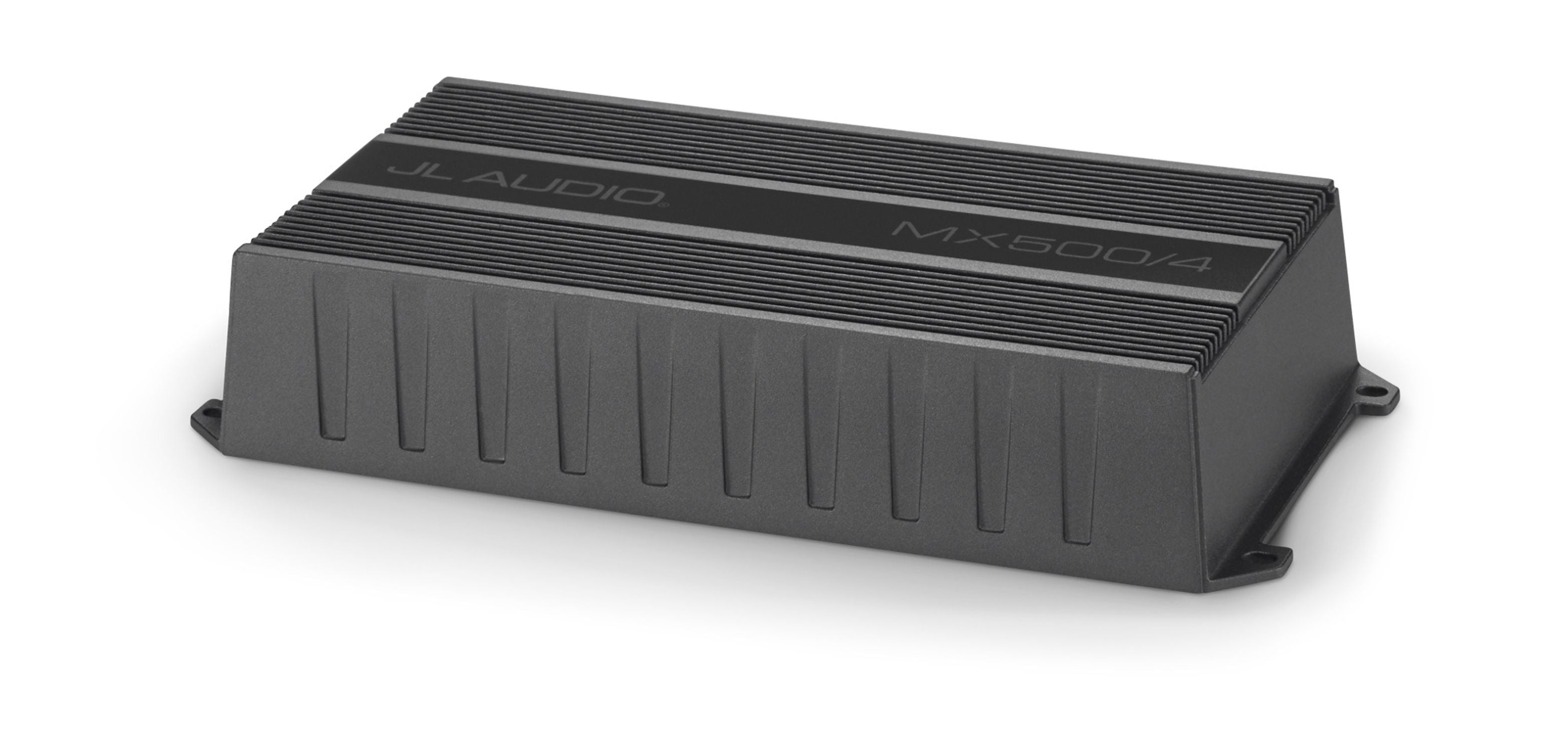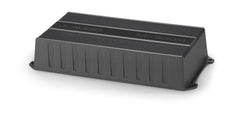Description
x4-Channel Class D Full-Range Amplifier, 125 W x 4 @ 2 Ω / 70 W x 4 @ 4 Ω - 14.4V
Engineered specifically for powersports applications, the 4-channel MX500/4 amplifier employs our high-speed NexD™ switching design to deliver plenty of clean power, without straining charging systems. Its tiny, cast aluminum chassis is highly resistant to corrosion, with an IPX7 water-resistance rating, making it perfect for motorcycles, ATV’s or other utility vehicles.
Generating a solid 70W x 4 into 4 ohms (14.4V, 1% THD), the MX500/4 is fully bridgeable, so it can be used as a 3-channel amplifier, or as a 2-channel amplifier producing a potent 250W x 2 into 4 ohms.
Other features include independent front and rear crossovers with selectable full-range, high-pass or low-pass filter controls and a dual-range input section that accepts a wide range of input voltage levels, from line-level all the way to high-power speaker level signals.
This amplifier features a rugged powder-coated finish, a gasketed cover for the controls and stainless steel hardware for durability.
| @ 4 Ω | 70 W RMS x 4 |
| @ 2 Ω | 125 W RMS x 4 |
| Bridged @ 4Ω | 250 W RMS x 2 |
| @ 4 Ω | 55 W RMS x 4 |
| @ 2 Ω | 90 W RMS x 4 |
| Bridged @ 4Ω | 180 W RMS x 2 |
| Frequency Response | 20 Hz - 20 kHz (+0, -1dB) |
| S/N Ratio, referred to highest rated power | >88 dB below rated power (A-weighted, 20 Hz - 20 kHz noise bandwidth) |
| S/N Ratio, referred to 1 W | >70.5 dB (A-weighted, 20 Hz - 20 kHz noise bandwidth) |
| Damping Factor @ 4 Ω | >92 / 50 Hz |
| Damping Factor @ 2 Ω | >43 / 50 Hz |
| THD+N @ Rated Power | <1% @ 2 Ω per Ch. |
| Input Voltage Range @ RCA Inputs | Switchable from 250 mV - 4 V RMS (Low) to 750 mV - 15 V RMS (High) |
| Min.Copper Power / Ground Wire Gauge | 4 AWG wire |
| Fuse Rating | 50 A (AFS, AGU or MaxiFuseâ„¢) |
| Filter Mode(s) | Low-Pass or High-Pass |
| Filter Slope(s) | 12 dB/octave |
| Filter Frequency Range | 35 Hz - 300 Hz |
| Detented, Calibrated Filter Freq. Potentiometers | Yes |
| Filter Defeat Function | Yes |
| Remote Level Control | No |
| Remote Level Modes | N/A |
| Channel Input Mode Switch | Yes (2/3/4 ch.) |
| Pass-Through Preamp Output | None |
| Source Channel Selection for PreOuts | N/A |
| Height (H) | 1.77 in / 45 mm |
| Width (W) | 9.33 in / 237 mm |
| Depth (D) | 4.50 in / 115 mm |
| Net Weight |
NexDâ„¢ Switching Technology
Summary:
NexDâ„¢ amplifier technologies produce exceptional audio quality, unsurpassed total efficiency and high power from very compact amplifier designs.
Detailed Information:
Beginning with the original 'Slash' subwoofer amplifiers, JL Audio has been at the forefront of Class D amplifier design. Our NexDâ„¢ switching technology stems from our Class D expertise to deliver outstanding fidelity and efficiency, leading to compact amplifiers that deliver high power and exceptional value.
Let's get a little nerdy... A traditional PWM switching amp design uses a fixed switching frequency and varies the pulse width based solely on the audio input signal to the pulse modulator. This basic approach assumes some ideal conditions, like a rock-steady power supply, that do not necessarily occur in a real, in-car installation. Power supply sag with signal causes distortion at all power levels with these designs, even well below clipping. The cure for this is feedback (a corrective signal sent back to the input side), but this becomes impractical as the audio frequency increases, making it a good solution for band-limited (subwoofer) amps, but not for full-range amplifiers.
Taking the above into account when designing the NexDâ„¢ subwoofer amplifiers, we have taken the simple fixed PWM approach and enhanced it with a very high switching frequency: 240 kHz, which is about 4x higher than most Class D subwoofer amplifiers. This pushes the amplifier's bandwidth to at least 500 Hz with minimal distortion and improves efficiency, while keeping typically bulky circuity more compact. Your subwoofers will reward you with tight, rock-solid bass performance.
For the full-range NexDâ„¢ amplifiers and channels we applied a variable, ultra-high speed version of the NexDâ„¢ technology (switching at well over 400 kHz). In these designs, a self-oscillating modulator with 'feed-forward' sends information about the instantaneous power supply voltage to the modulator, combining this with the input signal to cancel out any distortion due to supply voltage fluctuation. This reduces distortion prior to applying feedback, simplifying the overall feedback loop design.
The bottom line is simply great audio: clean, powerful and reliable.
Â
Â
Differential-Balanced Inputs
Summary:
JL Audio’s Differential-Balanced Inputs are engineered to combat induced cable noise, which is a common problem in car and marine audio installations. This technology allows for the use of conventional RCA cables, while delivering many of the benefits of a true balanced connection and accepting a wide range of input signal levels.
Detailed Information:
Today’s vehicles are equipped with sophisticated electronics capable of generating noise and interference that can intrude into the audio path, ruining the listening experience.
Most audio equipment uses single-ended, ground-referenced RCA jacks to receive audio signals. This means that the RCA shield is connected directly to signal ground. This is a simple, cost effective input design that works well for short runs in noise free environments. In noisier environments, this method cannot reject the common mode noise that could be on both RCA conductors (shield and center conductor).
By having more than one chassis-grounded RCA shield on a device, single-ended input designs are also more susceptible to ground loops. If noise is present on both conductors while the shield is connected to ground, the input amplifier will amplify the noise relative to the grounded RCA shield. When there are multiple RCA connections or any other conductors subjected to a magnetic field, this will cause a difference in potential across the RCA loop to be amplified at the grounded RCA as noise (a classic ground loop).
JL Audio’s Differential-Balanced Input circuits measure the center pin of the RCA connection relative to the RCA shield, even when the shield is not connected to ground, and even when the voltages at both conductors are moving relative to ground. Because both the center conductor and the shield see high impedance to ground at the input, a ground loop cannot be formed, as there is no current flow to induce a voltage as noise. This works equally well with differential-balanced, or unbalanced signal sources, making this input architecture compatible with all standard car and marine audio equipment, using standard, unshielded, twisted-pair RCA cables. No special cables are required, unlike the fully balanced connections used in professional audio.
Another benefit of the Differential-Balanced Input design is that it easily accepts low-level and high-level signals from a variety of factory head unit outputs and amplifiers, including single ended “ground referenced†sources, as well as Balanced or Unbalanced “Bridged or BTL†sources. This eliminates the need for Line Output Converters (LOCs) in most installation scenarios.
The obvious question is: “Why don’t all car audio amplifiers use Differential-Balanced Inputs?†The answer is simple: it costs more. Executing a proper differential-balanced input section requires more components and better quality components than a basic single-ended design, so you generally won’t find them on less expensive amplifiers.
Download  MX500/4 Product ManualÂ
USA Limited Warranty: Â Two (2) years from the original date of purchaseWarranty Details
Â
Find the answers to many common questions:
Â
Shipping & Return
xReturns Policy
You may return most new, unopened items within 30 days of delivery for a full refund. We'll also pay the return shipping costs if the return is a result of our error (you received an incorrect or defective item, etc.).
You should expect to receive your refund within four weeks of giving your package to the return shipper, however, in many cases you will receive a refund more quickly. This time period includes the transit time for us to receive your return from the shipper (5 to 10 business days), the time it takes us to process your return once we receive it (3 to 5 business days), and the time it takes your bank to process our refund request (5 to 10 business days).
If you need to return an item, simply login to your account, view the order using the "Complete Orders" link under the My Account menu and click the Return Item(s) button. We'll notify you via e-mail of your refund once we've received and processed the returned item.
Shipping
We can ship to virtually any address in the world. Note that there are restrictions on some products, and some products cannot be shipped to international destinations.
When you place an order, we will estimate shipping and delivery dates for you based on the availability of your items and the shipping options you choose. Depending on the shipping provider you choose, shipping date estimates may appear on the shipping quotes page.
Please also note that the shipping rates for many items we sell are weight-based. The weight of any such item can be found on its detail page. To reflect the policies of the shipping companies we use, all weights will be rounded up to the next full pound.
- Choosing a selection results in a full page refresh.




